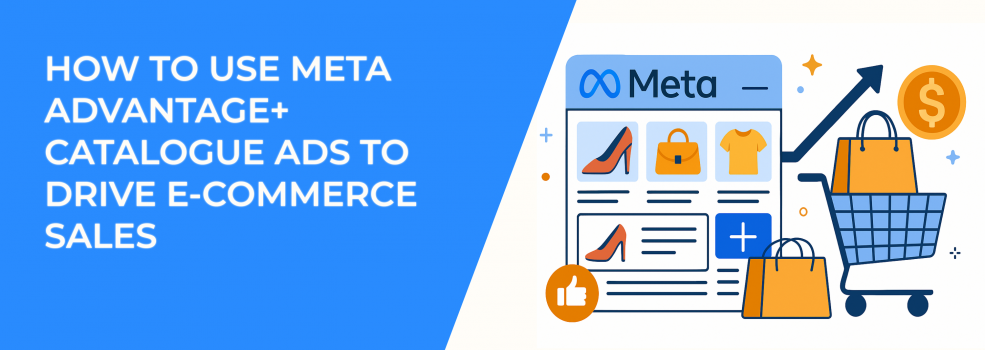If you run an online store and advertise on Facebook or Instagram, you’ve probably asked yourself: how can product ads be more personalized, more automated, and more effective — without the constant back-and-forth in Ads Manager?
Meta Advantage+ catalogue ads make this possible.
These ads rely on automation and behavior-based targeting to deliver highly relevant products to the right people at the right time.
Whether someone has interacted with your brand or is completely new, Advantage+ uses intent signals to guide what they see while cutting down on manual work. For advertisers trying to scale performance with less friction, they offer a smart solution.
Let’s take a closer look at how these ads work and how you can use them to increase conversions and drive more sales.
What Are Meta Advantage+ Catalogue Ads?
Advantage+ catalogue ads are dynamic product ads built around your existing product feed. They appear like standard carousel, collection, or single-image formats — but the product selection is automated and personalized for each user.
Meta’s algorithm chooses which products to show based on each person's engagement, interest, and shopping behavior. These ads can be used with several objectives:
-
Sales,
-
Traffic,
-
Engagement,
-
Leads,
-
App promotion.
With Advantage+ catalogue ads, you don’t need to manually create dozens of audience segments or upload individual creatives for each product. The system adapts and delivers the right items to the right people, so your campaign stays relevant and scalable.
Why Use Advantage+ Catalogue Ads for E-Commerce?
These ads aren’t just about automation. They give e-commerce brands a real edge in how they reach, convert, and grow their audiences — especially as Meta phases out some older audience targeting types.
Here’s what makes them worth using:
-
Personalized product delivery: Meta uses pixel, SDK, and platform signals to serve users items they’ve already viewed or might like.
-
Automatic creative formatting: Product images, pricing, and overlays are pulled from your catalogue and adjusted for each placement.
-
Scalable audience reach: Reach both new and returning customers without building manual targeting layers.
-
Flexible campaign integration: Use them inside Advantage+ sales campaigns or within your custom setups.
-
Stronger performance metrics: Advertisers have seen up to 39% higher ROAS and lower cost per purchase, especially when promoting catalogues with 20+ items.
This combination of automation, scale, and accuracy makes catalogue ads an efficient tool for selling more with less effort.
Broad Audiences vs. Retargeting: Two Ways to Use These Ads
Depending on your strategy, Advantage+ catalogue ads can help you acquire new customers or re-engage existing ones.
Broad Audience Targeting
Meta uses behavioral signals to identify people most likely to buy your products — even if they’ve never visited your website. This is useful for:
-
Launching new collections,
-
Reaching seasonal or high-intent shoppers,
-
Growing beyond your existing customer base.
You don’t need lookalikes or interest-based groups. Meta’s system handles the targeting and continues optimizing as your campaign runs.
Retargeting Audiences
For users who browsed your site but didn’t purchase, these ads are a powerful retargeting tool. You can:
-
Show products they recently viewed,
-
Recommend related items to encourage upsells,
-
Exclude past buyers from seeing the same offer again.
These actions are managed at the ad set level using custom audiences from your pixel, SDK events, or uploaded lists. Whether you want to nudge a cart abandoner or reconnect with a repeat buyer, you have the tools to do it.
How to Set Up Advantage+ Catalogue Ads (Step-by-Step)
Setting up these ads takes just a few steps, but details matter. A solid foundation ensures better delivery, cleaner reporting, and higher conversions.
Step 1: Optimize Your Product Catalogue
Inside Meta Commerce Manager, make sure your catalogue includes:
-
High-quality product images,
-
Clear, keyword-optimized titles and descriptions,
-
Accurate pricing and stock information,
-
Well-organized categories.
A well-maintained catalogue improves product matching and ad relevance. Using one central catalogue also simplifies inventory and campaign management.
Step 2: Connect Data Sources
Install the Meta Pixel, Conversions API, or Meta App SDK to track user actions and feed back real-time behavior. This data tells Meta who clicked, who added to cart, and who’s ready to buy.
Aim for a match rate of at least 75%, with 90% or higher being ideal. Poor data signals can limit reach and hurt performance.
Step 3: Choose the Right Campaign Structure
You have two main setup options:
-
Advantage+ sales campaign: Meta handles the targeting, creative, and budget optimization automatically.
-
Manual campaign with catalogue ads: You control the setup, with catalogue items added at the ad or campaign level.
Not sure which route to go? Here’s how to decide between Advantage+ automation and manual campaign setup.
For a deeper dive into full-funnel automation, see our guide to running Advantage+ sales campaigns for e-commerce.
There are also three ways to connect your catalogue:
-
Select "Use a catalogue" at the campaign level and choose product sets at the ad set level.
-
Set the creative source to your catalogue at the ad level.
-
Enable Advantage+ creative optimization and add catalogue items directly in your ad setup.
Try both approaches and track which gives better results for your products and budget.
Tips to Boost Catalogue Ad Performance
Even with automation, the right adjustments can significantly increase your return on ad spend.
Improve Catalogue Quality
-
Add detailed metadata — include colors, sizes, and product tags.
-
Use diverse images — lifestyle shots, angles, and clean product visuals.
-
Keep the feed updated — make sure pricing, availability, and content are current.
A stronger catalogue helps Meta serve better-performing ads and builds trust with shoppers.
Make the Most of Your Budget
-
Run prospecting and retargeting together — allow Meta to shift spend as needed.
-
Adjust based on performance — optimize based on ROAS and CPA by audience segment.
-
Use Pixel and Conversions API together — this gives Meta more reliable purchase data.
Efficient budget use means more conversions without overspending on underperforming audiences.
If you're scaling campaigns, learn how to optimize spend using Advantage+ budget allocation for smarter growth.
Refresh Your Creatives
-
Test videos in collection formats to hook attention early.
-
Add overlays with price drops or limited-time offers.
-
Include branded or creator content for authenticity.
Creative variety keeps your ads from going stale and helps drive action across placements.
Monitor and Adjust
-
Use Ads Manager breakdowns to see which products, placements, or devices perform best.
-
A/B test different product sets and exclude underperformers.
-
Watch for frequency spikes or drops in engagement to catch fatigue early.
Consistent monitoring ensures your ads stay fresh and continue delivering results.
Want to unlock the full power of the Advantage+ suite? Here’s how to maximize Meta Advantage+ tools for smarter advertising.
Final Thoughts
Meta Advantage+ catalogue ads are built for efficiency, relevance, and scale. They help e-commerce brands match the right product with the right customer automatically, using smarter data and simpler tools.
Whether you’re trying to drive more first-time purchases or re-engage shoppers who didn’t convert, these ads offer a flexible way to grow your online sales. And with traditional audience types evolving, leaning into automation and intent-based targeting is quickly becoming essential.
So set your catalogue up right, monitor your data sources, and let the algorithm do what it’s good at while you stay focused on strategy and results.

